Stonehenge may be Britain’s most recognisable prehistoric monument, but it is far from the oldest. Across the islands lie sites that predate it by centuries, sometimes millennia. These are places of ingenuity and imagination: homes, tombs, and monuments that whisper of lives lived thousands of years ago. In this article we’ll focus on seven remarkable sites scattered across Britain — each one older than Stonehenge — and delve into their stories in great depth. And if you’re inspired to explore them yourself, remember our bespoke, private tours can weave them into unforgettable journeys, tailored to your interests and pace.
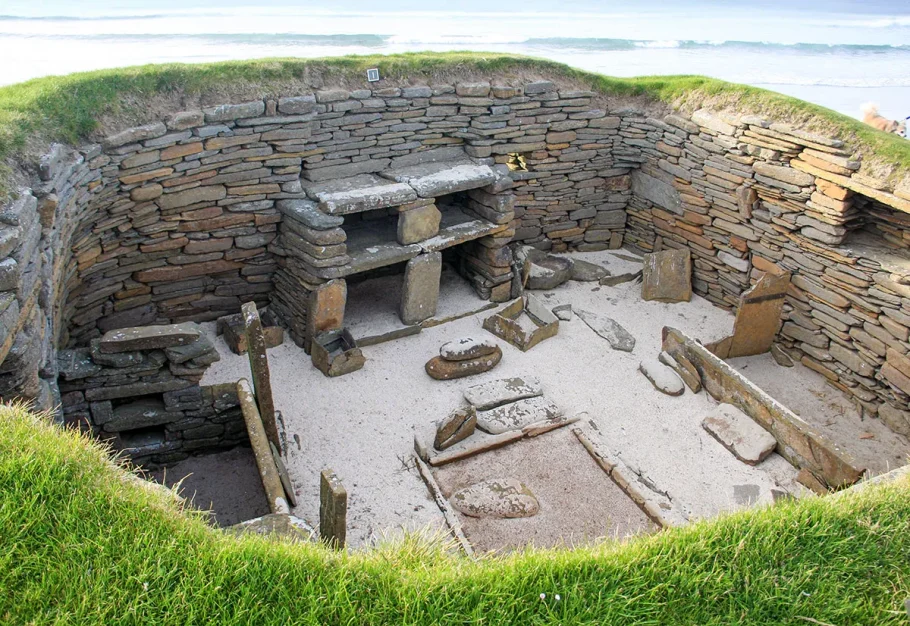
The winter storm of 1850 was so violent that it stripped away the turf covering a mound on Orkney’s Bay of Skaill. Beneath it lay a Neolithic village preserved in sand for nearly five millennia. Skara Brae, dating to around 3180 BC, is Europe’s best-preserved Stone Age settlement.
Walking the stone passages, you peer into homes with stone beds, central hearths, and “dressers” where prized objects may have been displayed. Each house was linked by covered passageways, so villagers could move between homes without braving the harsh Orkney gales. Archaeologists found gaming dice, jewellery, and tools — everyday objects that collapse the gulf of time. Imagine the laughter of children, the smell of peat fires, and the bustle of daily chores as waves crashed outside.
Skara Brae has reshaped how we think of the Neolithic. It demonstrates a society not of nomads scratching survival, but of farmers and artisans in a structured community. The presence of beads, carved bone pins, and even decorated pottery suggests pride in appearance and ritual. A particularly striking find was a carved stone ball, one of hundreds discovered across Scotland. Their purpose remains mysterious — were they weapons, weights, or ceremonial objects? Whatever their function, they show imagination and craftsmanship.
The site also provides a glimpse of resilience. Around 2500 BC, Skara Brae was abandoned. Whether due to climate change, shifting trade, or internal pressures, its people left behind a ghost village sealed by sand. Unlike most sites, no later settlement erased it. The result is a window into a single moment of the past.
Victorian visitors were astonished. One described it as “a Pompeii of the north,” frozen in time. To this day, Skara Brae reshapes our understanding of prehistoric life, showing that far from living in caves, Neolithic Britons built communities of comfort and sophistication.
On a bespoke tour, we often pair Skara Brae with Orkney’s other marvels to bring the island’s entire Neolithic story to life. We also weave in Orkney’s Norse legacy and thriving food culture, so your journey through time is complete.
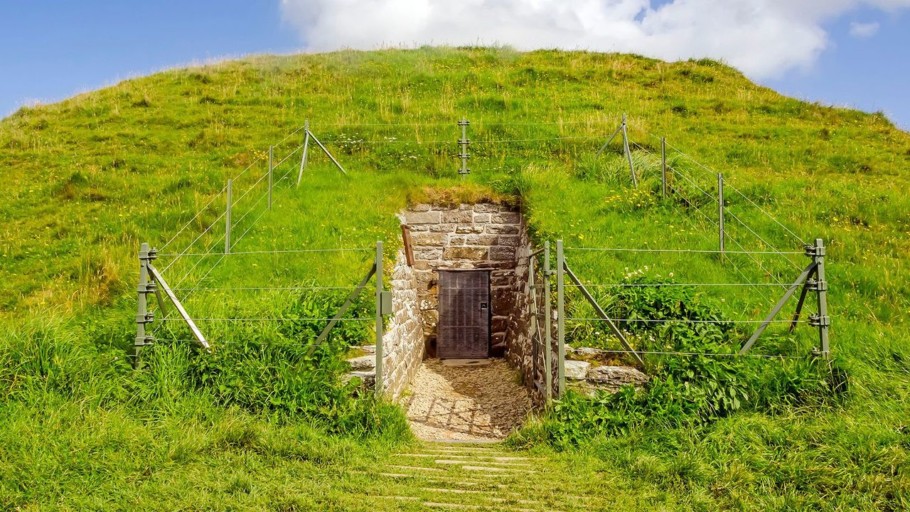
A few miles from Skara Brae rises a grassy mound that hides one of prehistory’s most extraordinary feats of engineering: Maeshowe passage tomb, built around 2800 BC. Its stone passage runs perfectly westwards, so that on the shortest day of the year, the setting sun streams through and illuminates the inner chamber. It is architecture as calendar, binding people together with light during the darkest days.
The tomb’s construction required astonishing skill. The inner chamber’s corbelled roof is built of enormous stone slabs, each overlapping slightly until they meet at the top. That roof has held firm for more than 4,000 years. The builders carried stone blocks weighing tons, cut precisely enough to lock together without mortar. The precision and permanence speak to both engineering prowess and spiritual devotion.
Maeshowe is layered with history. In the 12th century, Vikings broke in seeking treasure. Finding none, they carved runic graffiti into the walls: boasts, jokes, even love notes. One reads, “Ingigerth is the most beautiful of women.” Another, “These runes were carved by the man most skilled in runes in the western ocean.” Over 30 inscriptions survive, making Maeshowe the largest collection of runic writing outside Scandinavia.
The tomb’s rediscovery in the 19th century created a sensation. Antiquarians marvelled at both its Neolithic precision and its Viking afterlife. Today, stepping inside feels like entering a layered story — a place where prehistoric people tracked the heavens and medieval seafarers carved their presence into eternity.
You can time your visit to the solstice to see Maeshowe’s alignment or, when that’s not possible, to see solstice simulations in the visitor centre. Either way, the effect is unforgettable. For guests interested in astronomy, we expand the journey to include other solar and lunar alignments across Britain’s prehistoric landscape, creating a narrative of time and sky that stretches across the islands.
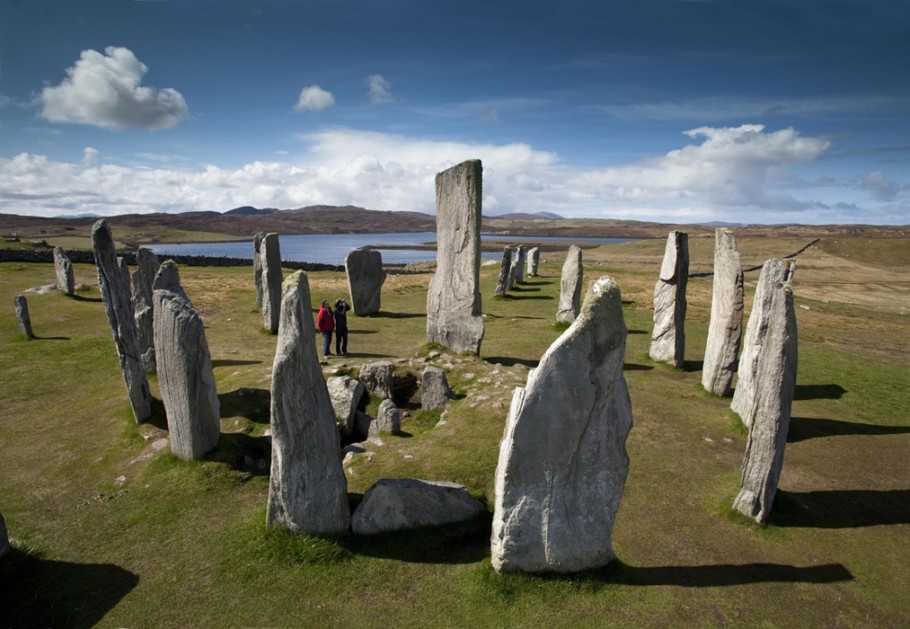
On the Isle of Lewis in the Outer Hebrides stand the Callanish Stones, raised around 2900 BC. Unlike Stonehenge’s circles, Callanish forms a cross-shaped pattern, with rows of stones radiating from a central ring. Many archaeologists believe the layout reflects lunar cycles, especially the “major lunar standstill” that occurs every 18.6 years when the moon skims low on the horizon.
But Callanish is as much about myth as measurement. Local folklore says the stones were once giants who refused to convert to Christianity and were petrified as punishment. Others whisper of the “Shining One,” a spectral figure seen walking the avenue of stones at midsummer dawn.
The stones were nearly lost. By the 19th century, peat had buried them to their shoulders. When the peat was cleared in 1857, the monument’s full majesty returned. Today, standing among the stones with the Atlantic winds howling, you understand why this place has always commanded awe.
Modern visitors often describe Callanish as more atmospheric than Stonehenge. With no fences or ticket booths, you can wander among the stones, touch their rough surfaces, and feel the sky open above you. Astronomers still debate the alignments, artists paint them, and islanders consider them part of the cultural fabric.
Our bespoke tours often pair Callanish with Harris tweed workshops or croft visits, showing how the landscape shapes culture both past and present. For those interested in astronomy, we time visits with lunar cycles to demonstrate the extraordinary precision of ancient skywatchers.
Not all ancient wonders are built of stone. In the Somerset Levels lies the remains of a wooden causeway called the Sweet Track, dendrochronologically dated to 3807 BC — making it one of the oldest known engineered roads in Europe. It once stretched nearly two kilometres across boggy wetlands, linking dry islands of settlement.
The track was constructed with oak planks laid on crossed supports of hazel and alder, all cut with stone tools. The precision is astonishing: timbers were shaped to interlock, pegged into place with sharpened stakes. This was engineering at a scale and complexity no one expected of the early Neolithic.
The peat preserved not only the wood but also artefacts dropped by those who crossed it: shoes made of leather, bowls carved from wood, tools of bone and antler. Together they paint a vivid picture of daily life. Imagine farmers carrying baskets of grain or children skipping along the track, keeping their feet dry as reed beds swayed in the breeze.
The Sweet Track also offers one of archaeology’s most fascinating examples of scientific precision. Using tree-ring dating (dendrochronology), researchers discovered that the oak trees used for the planks were felled in the winter of 3807 BC or the spring of 3806 BC. That makes the track older than the Great Pyramid of Giza by over a millennium. To be able to pinpoint the year, and even the season, when Neolithic people were chopping trees in the damp woodlands of Somerset is nothing short of breathtaking.
The causeway wasn’t just a practical pathway. Archaeologists believe the Sweet Track was also a symbolic one. Offerings such as jadeite axe heads (imported all the way from the Alps) and polished flint blades were found deliberately placed along the route, suggesting ritual significance. These weren’t accidental losses — they were gifts to the wetlands, places seen as liminal, mysterious, and powerful. Crossing the bog wasn’t only a way of getting from A to B, but also of engaging with a spiritual landscape.
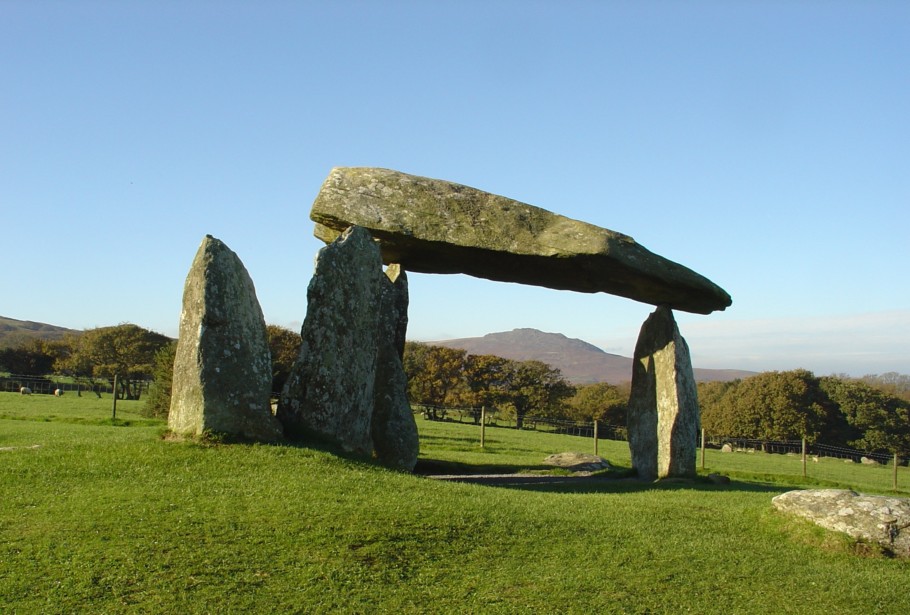
On a hillside in west Wales stands Pentre Ifan, a portal dolmen built around 3500 BC. Its massive 16-tonne capstone balances so delicately on three uprights that it looks as though it is levitating. Even in a land of stone tombs, Pentre Ifan stands apart for its elegance — light, airy, almost sculptural.
Originally, the dolmen was the doorway to a long cairn of stones covering a burial chamber. Time has stripped away the mound, leaving the skeletal frame of the structure. Yet in its stripped-down form, Pentre Ifan reveals the artistry of its builders. The balance is so precise that for centuries poets, painters, and even modern sculptors have marvelled at it as a work of art as much as a feat of engineering.
The location is significant, too. From the dolmen you can look out to the Preseli Hills, the very place where the bluestones of Stonehenge originated. Archaeologists debate how — and why — stones were transported some 180 miles from these Welsh hills to Salisbury Plain. Was it prestige, pilgrimage, or a shared cultural identity across regions? Standing at Pentre Ifan, gazing towards Preseli, you sense the connection between Wales’s ancient monuments and England’s most famous circle.
Local folklore adds another layer. Villagers told of fairies dancing around the stones at dusk, appearing as little red-capped figures who vanished when approached. The dolmen wasn’t just an empty ruin — it was a place alive in the imagination of local people for thousands of years.
When we take guests here, we often include a walk through the Preseli Hills, exploring not just Pentre Ifan but also the quarries where bluestones were pried loose. It makes for a day that ties myth, geology, and archaeology into one sweeping story — and on a bespoke tour, you can decide whether to focus on walking, history, or a mixture of both.
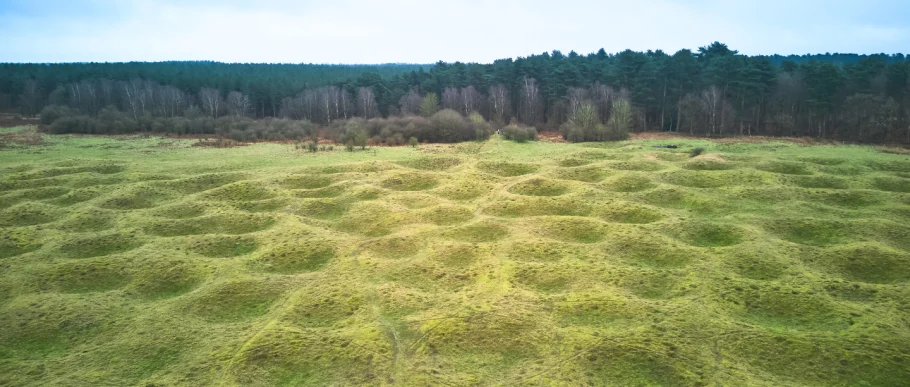
Travel east to Norfolk and the landscape changes. Gone are the stone circles and dolmens; instead, you find Grime’s Graves, a vast Neolithic flint mine. From the air, it looks like a moonscape — 400 depressions scattered across 37 hectares of heathland. Each marks the shaft of a mine dug between 2600 and 2200 BC.
The miners dug down as deep as 12 metres with nothing more than antler picks and stone tools. At the bottom, they carved galleries into the chalk to follow seams of the finest flint. Crawling on their bellies by the light of burning tallow lamps, they hacked out nodules that were then shaped into axes, scrapers, and blades. Flint was the steel of its day — the essential raw material of Neolithic technology.
The risks were real. Archaeologists excavating one shaft in the 20th century found the skeleton of a miner who had been trapped when the chalk collapsed. His tools still lay nearby. It’s a poignant reminder that prehistoric life wasn’t only ritual and ceremony, but also backbreaking labour and danger.
The name “Grime’s Graves” is itself a window into cultural memory. In Anglo-Saxon times, “Grim” was another name for the god Woden, and locals believed the pits were his dwelling. They imagined the hollows as the work of a deity, not of long-forgotten miners.
Today you can descend into one of the excavated shafts — a unique experience where you feel the close, chalky air and the rough tool marks on the walls. It’s both claustrophobic and awe-inspiring. On our private tours, we often pair Grime’s Graves with demonstrations of flint knapping by local experts, showing how miners’ raw material was transformed into tools that shaped Neolithic Britain. Guests come away with a vivid sense of both the ingenuity and the toil of the ancient world.
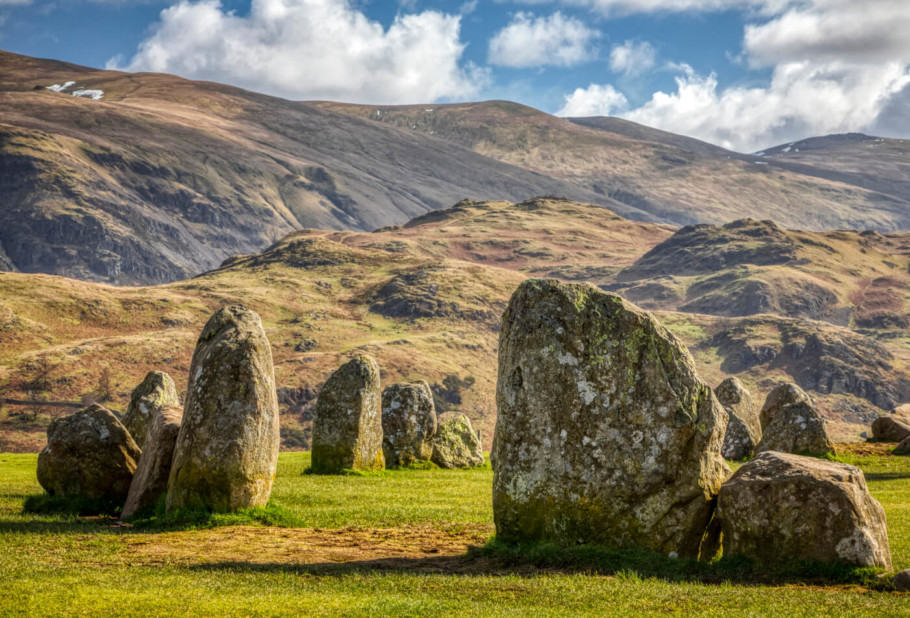
Set on a natural plateau near Keswick in the Lake District, Castlerigg Stone Circle is one of Britain’s most atmospheric prehistoric sites. Raised around 3000 BC, it consists of 38 stones forming a near-perfect circle, surrounded by the dramatic peaks of Helvellyn, Blencathra, and Skiddaw. The location is breathtaking — it feels as though the mountains themselves were chosen as a backdrop to amplify the monument’s power.
Unlike Stonehenge, Castlerigg has not been heavily reconstructed, and it has never been enclosed. You can walk among the stones, touch them, and take in the shifting play of light across the fells. This openness gives it a sense of intimacy and timelessness that has captivated visitors for centuries. Wordsworth and Coleridge, poets of the Romantic movement, visited the circle and wrote of its quiet majesty as proof of humankind’s eternal connection with nature.
What was Castlerigg’s purpose? Archaeologists still debate. Some suggest it was a market site for exchange between communities; others see it as a ritual centre tied to celestial alignments. The circle’s orientation hints at solstice and equinox connections, while the enclosing peaks may have played a role in how the builders tracked the heavens.
For modern visitors, Castlerigg is often described as more moving than Stonehenge — not because it is larger, but because its setting is unmatched. As the sun sinks behind the fells, the stones seem to glow with an inner fire.
Our bespoke itineraries often combine Castlerigg with the Lake District’s cultural heritage: Wordsworth’s Dove Cottage, boat rides on Derwentwater, and farm visits that showcase Cumbrian life. The effect is to place the stone circle in a wider story of landscape, literature, and community that stretches across millennia.
Each of these sites offers a glimpse into Britain before Stonehenge: homes, tombs, causeways, and circles that reveal how inventive, resilient, and interconnected Neolithic societies were. They built with stone, wood, and bone; they tracked the stars; they honoured their dead and celebrated their landscapes.
But visiting them is not always straightforward. Some are remote, others fragile, many poorly signposted. That is why our private, bespoke tours are invaluable: we connect the dots, providing the context that brings them alive, while tailoring each journey to your interests — whether that’s archaeology, folklore, landscape, or simply the thrill of discovery.
Older than Stonehenge does not mean forgotten. These places endure — in stone, timber, peat, and memory — waiting to be encountered by those who seek Britain’s deepest past.
25 August 2025